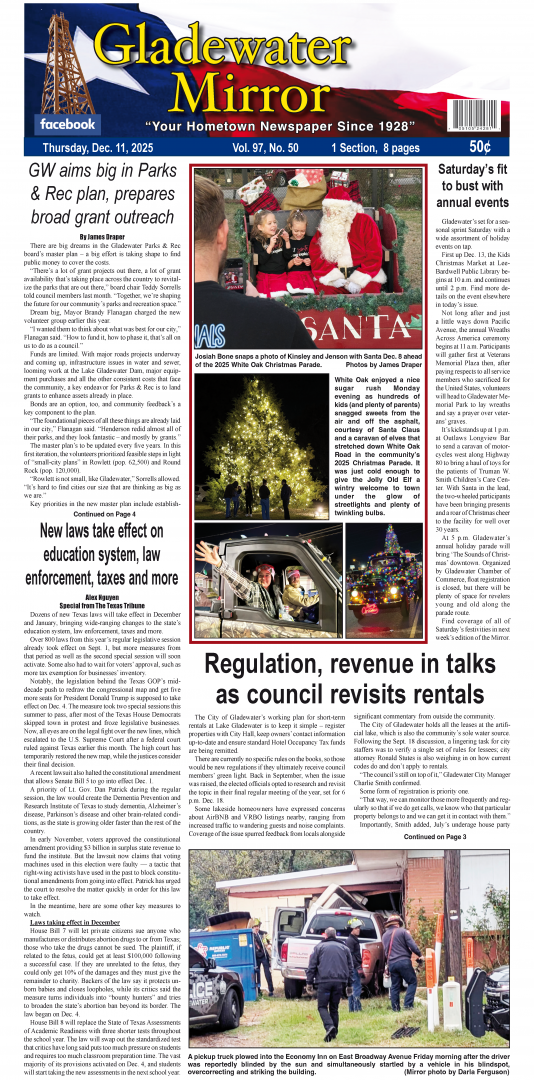It’s one step at a time to get the dam at Lake Gladewater back into solid condition – progress is gradual, so far, but at least it’s measurable.
While the June 16 storm delayed certain tasks, a couple of key tasks were accomplished the past month, Gladewater Fire Chief & Emergency Coordinator Mike Simmons reports.
An essential item on the list: Trim down the vegetation on the back side of the earthen dam. Done.
Considering the steep grade, Simmons said, the contractor had to use a robot mower to finish the task earlier this month.
“The next thing on our list was to get the dam plan re-done,” he said. Check. “August 1 we’ll do our review of it with the emergency management coordinators of Gregg County, Upshur County, city manager (Charlie Smith) and a representative of TCEQ then we’ll all sign it and submit that to the state for approval.”
The Texas Commission on Environmental Quality is the prime authority over dams in Texas, working alongside the Texas Department of Emergency Management.
Meanwhile, “We’re working with an engineer on the updated inundation zone map,” charting the course floodwaters would flow were the dam to suffer a catastrophic failure. Meanwhile, once the TCEQ-approved burn of storm debris is complete, “We’ll get out there and test the valve, make sure that it’s working and everything’s good. That’s our emergency control,” should the water level behind the dam ever top 310 feet above sea level, the height of the dam.
“If it ever starts to rise above, we’ll open that (valve) and try to keep it from cresting the dam.”
The most significant aspect of the mid-June storm was wind, not rain, he added. It and other recent weather events had no appreciable change to the Lake Gladewater water level. A more significant rainfall event could reveal existing flaws in the dam without creating new problems.
“You see a little rooster tail coming out of it. When it’s flowing full force, you can really see the differences.”
After attending a dam workshop in Austin, Simmons expects it’s 50/50 whether Gladewater will qualify for federal funding administered by the state. As always, it’s a question of how much is in the channel and how many others are trying to draw on it.
“Traditionally, if your dam is in poor standing, you qualify,” Simmons said. “The front of our dam is in decent shape. The back side of our dam is in poor shape. The concrete structure has new deficiencies that we’re noting.
“We’re up for our next annual inspection in August. We’ll have last year’s that we did and this year’s that we did, and I have the one from 10 years ago. You can see where there’s more erosion. The one we did this year will show more of the deficiencies in the concrete structure.”
More professional analysis is necessary to fully understand the state of the dam.
“All of these problems are not that big of a deal except you’re one storm away from it becoming a problem,” Simmons said. “It could be 20 years and it could be the next storm if you have erosion, washout, sunken concrete panels.
“Without the engineering, if something is going on inside the structure, you don’t know. We’re going to try to probe into those spaces and see if there are big voids.”
At least, he added, Gladewater is back in good standing on its reports.
With a new game plan in place and updated inundation maps in the works, it’s unlikely requests from the city will be dismissed outright.
“If we don’t get anything this year, next year we’ll be in a better spot because we’ll have checked things off what we’ve prepared,” he said. “It kind of makes sense, because they’re not going to put money into something we’re not putting money into.
“Once we show our efforts to resolve things – that we’re doing what we can to repair this structure, but it’s so big it’s hard for us to do – that’s how the grant funds will kick in. We can have a conversation now, understanding that things need to get done.”









